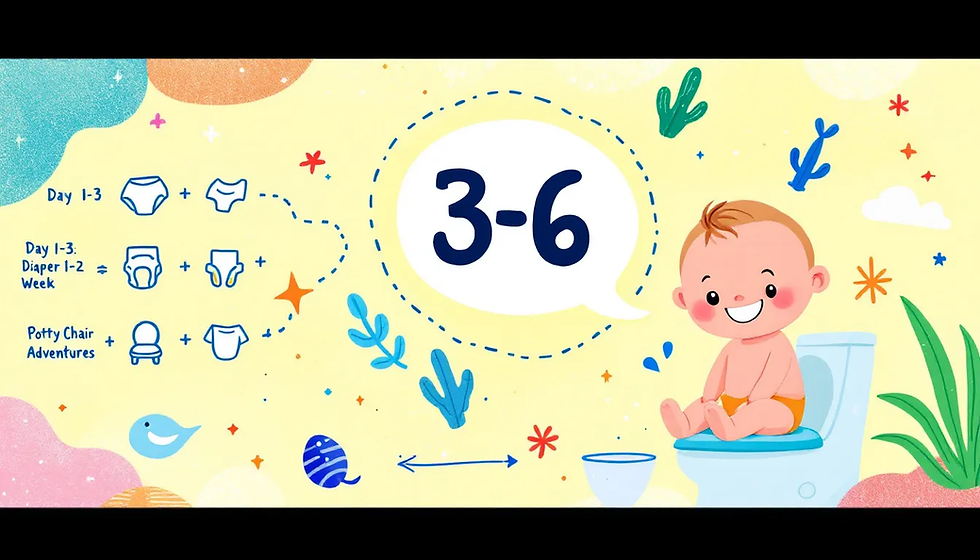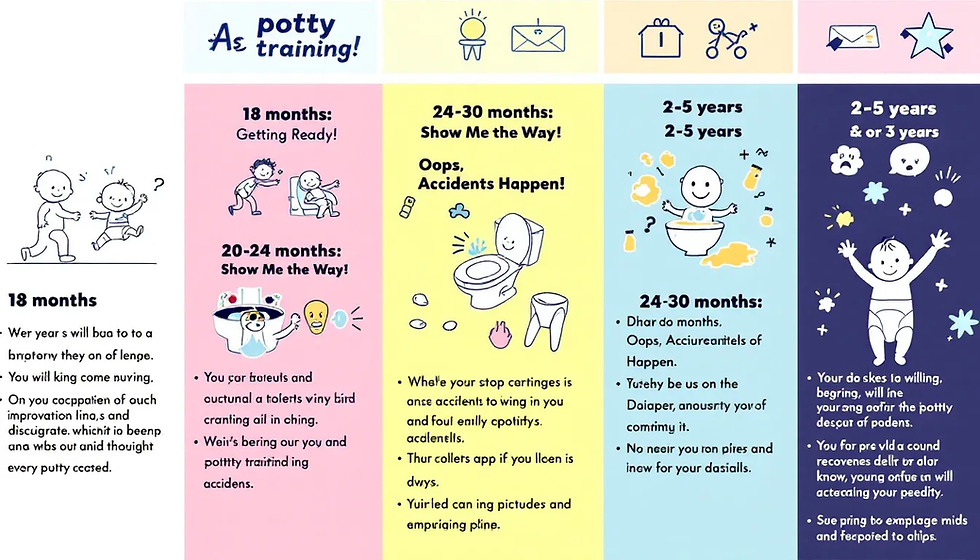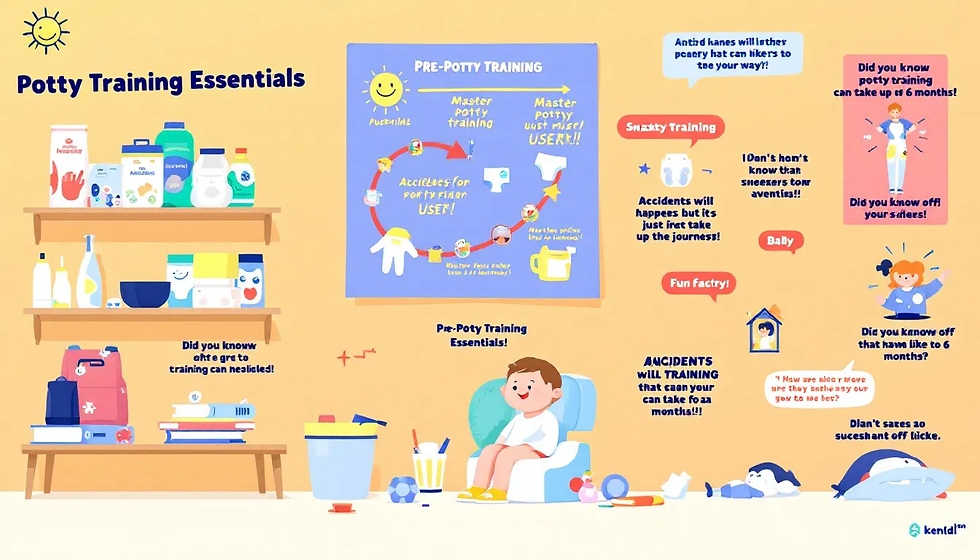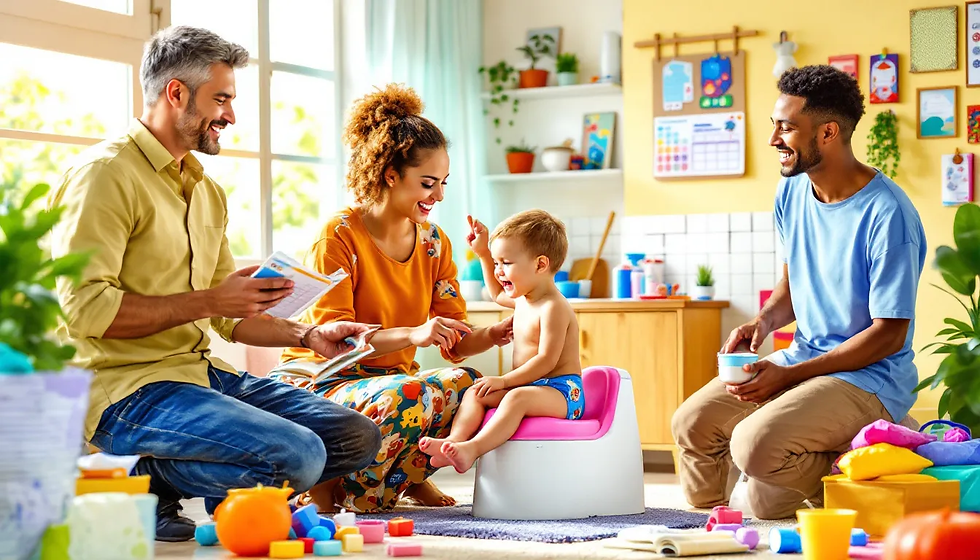How Long Does Potty Training Take? Practical Tips for Parents
- The Parent Corner

- Apr 16
- 7 min read
If you're wondering how long potty training takes, on average, it takes about six months, but it can range from a few weeks to several months depending on the child. This article will guide you through factors affecting the timeline and practical tips to help your child succeed.
Key Takeaways
Potty training typically takes over six months, varying widely by child; most children may take weeks, while others could take longer.
Recognizing signs of readiness, like staying dry for two hours, is essential for a smooth potty training experience.
Creating a supportive environment and using positive reinforcement can significantly ease the potty training process for children.
Understanding the Average Time for Potty Training

Potty training is a significant milestone, but it’s rarely a swift one. On average, it takes just over six months for a child to become fully potty trained. Yet, the timeline can vary significantly. Some children might grasp the concept in a matter of weeks, while others may long does potty training take several months or even longer.
Take, for example, Clare, whose child managed to grasp the basics in three days but still experienced accidents for about a month. Accidents are common, especially in the early stages of potty training. On the other hand, Steph’s son took a few months, illustrating that each child’s journey is unique. When Clare's daughter started potty training, she experienced accidents for about a month. Some parents find that their children understand how to urinate in the potty within a week, but bowel movements might take about a week longer to master.
It’s also important to note that staying consistently dry at night can take much longer—sometimes months or even years. This wide range in potty training duration underscores the importance of patience and flexibility. Each child is different, and their path to being fully potty trained will be uniquely their own. It's typical for accidents to happen as children learn to use the toilet effectively.
Age Milestones in Potty Training

Age plays a crucial role in potty training readiness. Typically, children complete potty training by the age of three. However, boys and girls often reach this milestone at different times. Girls usually begin potty training between 22 and 30 months, achieving success a bit earlier than boys, who might start around six months later. For instance, a boy might start potty training around six months later than a girl. A daughter might show readiness signs earlier, making the process smoother.
Children generally begin to develop the necessary skills to start potty training between 18 and 24 months. This period is critical as kids started potty training to gain bladder control and the ability to follow simple instructions—key components of successful potty training.
These are just averages. Some young children might be ready earlier, while others might need more time. Paying attention to your child’s behavior and cues can be more important than strictly adhering to age milestones.
Factors Influencing Potty Training Duration
Several factors influence how long potty training will take. Cognitive readiness is crucial—your child should be able to follow simple instructions and have the vocabulary to describe their needs. Moreover, creating a routine that encourages regular bathroom visits, such as after meals and upon waking, can significantly aid the process. Parents who decided to use the three-day potty-training method often evaluate their child's readiness first.
Consistency among caregivers also plays a significant role. For instance, one parent found that watching their son’s behaviors post-meal helped time potty sessions, eventually greatly improving his understanding of the process.
Family dynamics, too, play a role. Firstborn children often take more time to potty train compared to their youngest siblings. Additionally, the unique journey of each child means that flexibility and patience are paramount. Remember, no one child is the same, and each will have a unique potty training journey.
Signs Your Child is Ready for Potty Training
Recognizing the signs of potty training readiness is crucial for a smooth transition. One key indicator is when a child regularly stays dry for at least two hours, showing signs that their bladder muscles are sufficiently developed. Being able to pull down their pants and sitting on the potty are key readiness signs. A child’s interest in the bathroom habits of others can also signal readiness.
Using simple language around restroom activities can help children understand what to expect, easing them into the process. Moreover, a child’s temperament can affect how quickly they adapt to new routines, influencing the duration of potty training.
Family dynamics, like moving to a new house or the arrival of a new sibling, can delay readiness. Waiting for a child to show these readiness signs can result in a more positive and smoother potty training experience. If concerns arise, such as a lack of interest in toilet training by age 2.5 or not being trained by age 3, consulting a healthcare provider is advisable.
Making Potty Training Easier

Creating a supportive and positive environment is key to making potty training easier. Show appreciation when your toddler uses the toilet, but avoid excessive excitement to prevent performance anxiety. If toddlers perceive using the toilet as stressful, they may develop an aversion to it. Using a toilet insert can make the transition from a potty chair to a full-size toilet easier for your child.
Address any pain during bowel movements immediately to prevent reinforcing a child’s reluctance to use the toilet. As children progress, be prepared to adapt your techniques based on their changing focus and engagement.
Recognizing your child’s signals for needing to use the potty can help minimize accidents in the early stages. One effective strategy is using two layers of thin pajama pants to help children recognize when they are wet, enhancing their awareness. Accidents on the floor are common, so it's important to stay calm and supportive. Staying calm and supportive during accidents is crucial for maintaining your child’s confidence.
Common Challenges and How to Overcome Them
Potty training comes with its own set of challenges. Kids may exhibit anxiety due to fears about the toilet or previous painful experiences. If a child refuses to use the toilet, it might indicate they aren’t psychologically ready for potty training. Night time dryness can take longer to achieve and is often considered a separate milestone.
Introducing practice potty sessions with short durations can help ease a child’s fear and encourage acceptance. For children hesitant to pee, the sound of running water can sometimes encourage them to wash.
Daytime accidents are a normal part of the journey, depending on the child’s developmental stage. If a child consistently holds back poop, it’s important to seek advice from a pediatrician. Also, occasional accidents can be addressed with a child-sized potty that has proper foot support, making the child feel more secure and comfortable during rest. Accidents occur, and understanding this can help ease the process. It’s essential to wait for the child to feel ready. The child sat on the potty, which can help in this transition. It’s a big deal, and recognizing that accidents are happening is part of the journey. Parents often find the second time potty training easier due to increased experience.
When to Seek Professional Help
Sometimes, despite our best efforts, potty training challenges persist. If your child hasn’t mastered daytime potty training by age 4, it might be time to consult a pediatrician. Recognizing when a child is struggling is essential for their development.
Monitoring your child’s progress and discussing any concerns with a pediatrician can ensure that any developmental issues are addressed early. Seeking professional advice and using a method can provide you with additional strategies and peace of mind.
Potty Training Methods

There are various potty training methods, each with its own set of pros and cons. The three-day potty training approach involves keeping the child diaper-free for three days to quickly teach them toilet use. Starting the three-day potty-training method over a long weekend can provide the necessary focus and time. Increased fluids during this period can promote frequent urination and practice opportunities.
Gradual potty training can sometimes lead to confusion if it involves switching between diapers and underwear, potentially disrupting the learning process. Using training pants or pull-ups might lessen the sensation of being wet, making it harder for children to recognize when they need to use the toilet.
Creating a positive atmosphere is crucial. Offering rewards, like stickers or extra playtime, can motivate children to use the potty. Shorter, more frequent practice runs to the potty can help children learn the process better. Encouraging children to sit on the potty for a few minutes can normalize the experience.
Real-Life Experiences from Parents
Nothing beats learning from those who have been through the process in their own time. One parent found valuable insights by observing a cousin’s successful potty training with her girl child. Many parents have shared their unique experiences, reflecting a wide range of timelines and approaches.
Each child’s potty training journey is different, showcasing the individuality of the process for every child. Sharing your own stories and observations can foster a supportive community where parents can learn and grow together.
Summary
Potty training is a significant milestone in a child’s development, and while the journey can vary widely, patience and consistency are key. Accidents will happen, and understanding this can help ease the process. From understanding the average time it takes, recognizing readiness signs, to knowing when to seek professional help, every step is crucial.
Remember, each child is unique, and their path to being fully potty trained will be uniquely their own. Stay calm, supportive, and flexible. You’ve got this!
Frequently Asked Questions
How long does potty training usually take?
Accidents will happen, and potty training usually takes a little over six months, but keep in mind it can range from just a few weeks to several months depending on the child. Patience and consistency are key!
At what age should I start potty training my child?
You should aim to start potty training your child between 18 and 24 months, as most kids are fully trained by around age three. When my daughter started potty training at 18 months, I noticed that just looking for signs of readiness in your little one is crucial!
What are the signs that my child is ready for potty training?
Your child is likely ready for potty training if they can stay dry for at least two hours, sitting on the potty, show curiosity about bathroom habits, and follow simple instructions. These signs indicate they’re becoming more aware of their bodily needs and can start this important step.
What should I do if my child is afraid of using the toilet?
If your child is afraid of using the toilet, accidents on the floor are common. Try introducing practice potty sessions and using techniques like running water sounds to help ease their fear. This approach can make the experience more comfortable and encouraging for them.
When should I seek professional help for potty training?
You should seek professional help for potty training if your child isn’t fully daytime potty trained by age 4 or if you have ongoing concerns. Even if your child has never had an accident, it’s better to check in with a pediatrician for guidance if you’re feeling unsure!




Comments